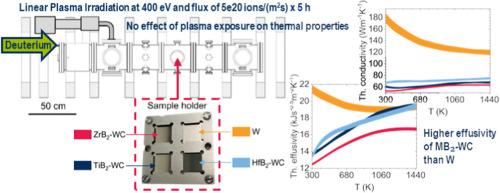Thermal properties of MB2-WC (M = Ti, Zr, Hf) and tungsten and their stability after deuterium plasma exposure
IF 2.9
Q1 MATERIALS SCIENCE, CERAMICS
引用次数: 0
Abstract
The thermal properties of ultra-high temperature ceramics (UHTCs) in the MB2-WC (M = Ti, Zr, Hf) system and tungsten were studied for potential application as plasma-facing materials in fusion power plants. The sintered UHTC and tungsten samples were subjected to deuterium plasma or protons irradiation. Thermal diffusivity was measured using the laser flash method, and superficial thermal conductivity was analyzed through atomic force microscopy. Results showed that the thermal properties did not degrade when exposed to relevant environments and remained stable over a range of temperatures, unlike the reference tungsten material. Thermal conductivity ranged from 61 to 68 W m−1 K−1 for TiB2-2(WC-6Co), from 53 to 63 W m−1 K−1 for ZrB2-6WC, from 67 to 75 W m−1 K−1 for HfB2-6WC, and from 180 to 119 W m−1 K−1 for tungsten across the temperature range from room temperature to 1200 °C. The increasing trend of thermal effusivity, over 19000 J s−0.5 m−2 K−1 at 1200 °C, justifies further testing and of UHTC materials for fusion applications.

MB2-WC (M = Ti、Zr、Hf)和钨的热特性及其在氘等离子体暴露后的稳定性
研究了MB2-WC(M = Ti、Zr、Hf)系超高温陶瓷(UHTC)和钨的热特性,以探讨其作为等离子体面材料应用于核聚变发电厂的可能性。对烧结的超高纯钛和钨样品进行了氘等离子体或质子辐照。使用激光闪光法测量了热扩散率,并通过原子力显微镜分析了表面热导率。结果表明,与参考钨材料不同,热性能在暴露于相关环境时不会退化,并且在一定温度范围内保持稳定。在室温至 1200 °C 的温度范围内,TiB2-2(WC-6Co) 的热导率介于 61 至 68 W m-1 K-1 之间,ZrB2-6WC 的热导率介于 53 至 63 W m-1 K-1 之间,HfB2-6WC 的热导率介于 67 至 75 W m-1 K-1 之间,钨的热导率介于 180 至 119 W m-1 K-1 之间。热效率呈上升趋势,在 1200 ℃ 时超过 19000 J s-0.5 m-2 K-1,这证明有理由对用于聚变应用的超高导热系数材料进行进一步测试。
本文章由计算机程序翻译,如有差异,请以英文原文为准。
求助全文
约1分钟内获得全文
求助全文
来源期刊

Open Ceramics
Materials Science-Materials Chemistry
CiteScore
4.20
自引率
0.00%
发文量
102
审稿时长
67 days
 求助内容:
求助内容: 应助结果提醒方式:
应助结果提醒方式:


